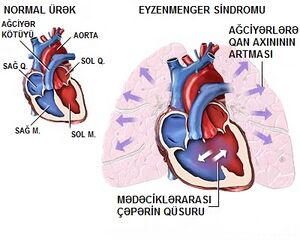Eisenmenger's syndrome
From WikiLectures
Eisenmenger's syndrome is a short-circuit defect at any level (aortopulmonary, atrial, ventricular) along with secondary pulmonary hypertension. It results in the change of the original left-right short circuit to right-left.
- Pulmonary hypertension significant;
- pathogenesis unclear (pulmonary burden on the volume of recirculating blood);
- media hypertrophy, fibrotization and cellular infiltration of the intima of the pulmonary branches (pulmonary vascular disease);
- hypertrophy and right ventricular insufficiency (insufficiency of the tricuspid valve).
Clinical picture[edit | edit source]
- Progressive dyspnea;
- clubbed fingers;
- cyanosis.
Diagnostics[edit | edit source]
- Tricuspid insufficiency (prominent wave "a" on the venous pulse in the neck);
- curious right ventricular stroke subxifoidally;
- systolic ejection crank; systolic murmur above the lungs with emphasis II. echoes;
- ECG: hypertrophy of the right atrium with prominence of P wave in leads II, III, aVF;
- Chest x-ray: prominence of the pulmonary arch;
- ECHO: presence of congenital heart disease, signs of pulmonary hypertension, consequences.
Therapy[edit | edit source]
- Eisenmenger syndrome cannot be treated;
- important prevention by cardiac surgery in childhood;
- heart and lung transplantation;
- reason for abortion for health reasons.
Links[edit | edit source]
[edit | edit source]
- congenital heart defects
- Congenital malformations
References[edit | edit source]
- Template: Quote

